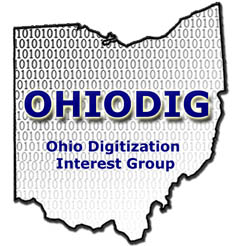RESOURCES
Digitization and digital projects
“Moving Theory into Practice” Digital Imaging Tutorial: Guide from Cornell University providing a comprehensive overview of the techniques, specifications and guidelines involved in digitization.
Minimum Digitization Capture Recommendations: Updated guidelines from ALA and the Association for Library Collections and Technical Services Preservation and Reformatting Section for digital capture of static and time-based media. Formats addressed include books, manuscripts, maps, photographs, audio, video and more.
OCLC’s Digital Imaging Project Preparation Toolkit: Documents that provide guidance on estimating the costs of a digital reformatting project and creating RFPs for your own institution.
Digitizing Video for Long-Term Preservation: An RFP Guide and Template: Step-by-step guide from NYU Libraries for drafting an RFP for digitization of analog video. Includes template and glossary of video preservation terms.
Lighting Methods for Photographing Museum Objects: By Carl Bigras, Mylene Choquette, and Jeremy Powell. Published by the Canadian Conservation Institute. This is a good reference manual, with illustrations, showing lighting setups that work well for various objects. (Requires knowledge on how to use manual controls on a DSLR camera, and understanding the differences between types of lenses.)
Light: Science and Magic: By Fil Hunter, Steven Biver, and Paul Fuqua. This book is somewhat more theoretical and takes a lot longer to absorb. But it’s very useful for thinking about light and how it behaves. (Requires knowledge on how to use manual controls on a DSLR camera, and understanding the differences between types of lenses.)
Photographing Manuscripts: By Amy McCrory. Blog post on photographing manuscript material with a copystand camera set up with emphasis on specular lighting on reflective materials.
Knowyourcarrier.com: decision tree to help identify audiovisual and photographic carriers.
Copyright
American Library Association copyright tools: ALA provides access to resources to help with copyright decisions, including the Public Domain Slider, the Section 108 Spinner, the Fair Use Evaluator, and the Exceptions for Instructors eTool.
Digital Copyright Slider: A detailed resource for determining copyright status of a work based on its date of first publication.
Columbia University Fair Use Checklist: Columbia’s Copyright Advisory Services unit provides this tool and associated information to evaluate whether activities fall under Fair Use using the four factors outlined in Section 107 of the U.S. Copyright Act.
Copyright and Cultural Institutions: Guidelines for Digitization for U.S. Libraries, Archives and Museums: Written by Peter Hirtle, Emily Hudson and Andrew T. Kenyon, this article explores how professionals can understand and comply with copyright law in the changing digital landscape.
Recommendations for the Technical Infrastructure for Standardized International Rights Statements: White paper from the International Rights Statements Working Group, with representatives from Europeana, Creative Commons and DPLA. This paper offers recommendations for a shared set of rights statements to be used among cultural heritage organizations around the world.
Assessment
DLF Assessment Interest Group: Wiki page for the DLF’s Assessment Interest Group which serves as a central location for documentation and collection of resources to assist those seeking to assess their digital libraries. The DLF AIG also has a Slack workspace and Google Group.
Association of Research Libraries SPEC Kit 341–Digital Collections Assessment and Outreach: This SPEC Kit investigates what methods ARL member libraries use to maintain the relevancy of their locally curated digital library collections, and to continue to sustain, grow, capture return on investment, and enhance existing resources through outreach and assessment. The survey also explores current practices for integrating digital resources into the research, teaching, and learning environment.
Preservation and sustainability
“Searching for Sustainability: Strategies from Eight Digitized Special Collections”: In-depth report from the Association of Research Libraries on the challenges involved in pursuing a digitization project that will be sustainable, accessible and relevant over time. Includes case studies, examples of good practice and markers of sustainability.
Digital Preservation Policy Framework: A Case Study: By Dan Noonan. A case study published in EDUCAUSE Review that documents the process of developing a digital preservation policy, and how to take incremental steps towards adopting one.
Promotion and statewide projects
Connecting to Collections new media resources: Presentation and handout on promoting your preservation efforts (digital or otherwise) through creative use of new media.
Ohio Digitization Hubs Project: Overview, timeline, contact information and more for the Ohio DigiHubs Project, funded with federal LSTA funds via the State Library of Ohio. Includes links to original grant proposal and four participating libraries around the state.
Ohio Digital Network: Overview of Ohio’s DPLA service hub operating out of the State Library of Ohio. Includes information about contributing to DPLA, events, blog posts, metadata information, and information for users and educators.
Accessibility
“Image Accessibility for Digitized Collections” by Sidney Gao, Digital Collections Manager, University of Cincinnati Libraries.
Poet Training Tool: Developed by The DIAGRAM Center (Digital Image And Graphic Resources for Accessible Materials), a Benetech Global Literacy initiative, the Poet Training Tool is a web based image description resource that helps people learn when and how to describe various types of images frequently found in educational books. Users of this tool have access to best practice guidelines and hands-on exercises that help cultivate skills for writing effective image descriptions for critical visual content.
Transcription Style Guide: Wright State University student workers uses the Tigerfish style guide (particularly the verbatim section) only, not their transcription service.
last updated: 2024-03-21 || URL: https://www.ohiodig.org/resources || maintained by: Marsha Miles || questions or comments: m.a.miles24@csuohio.edu
